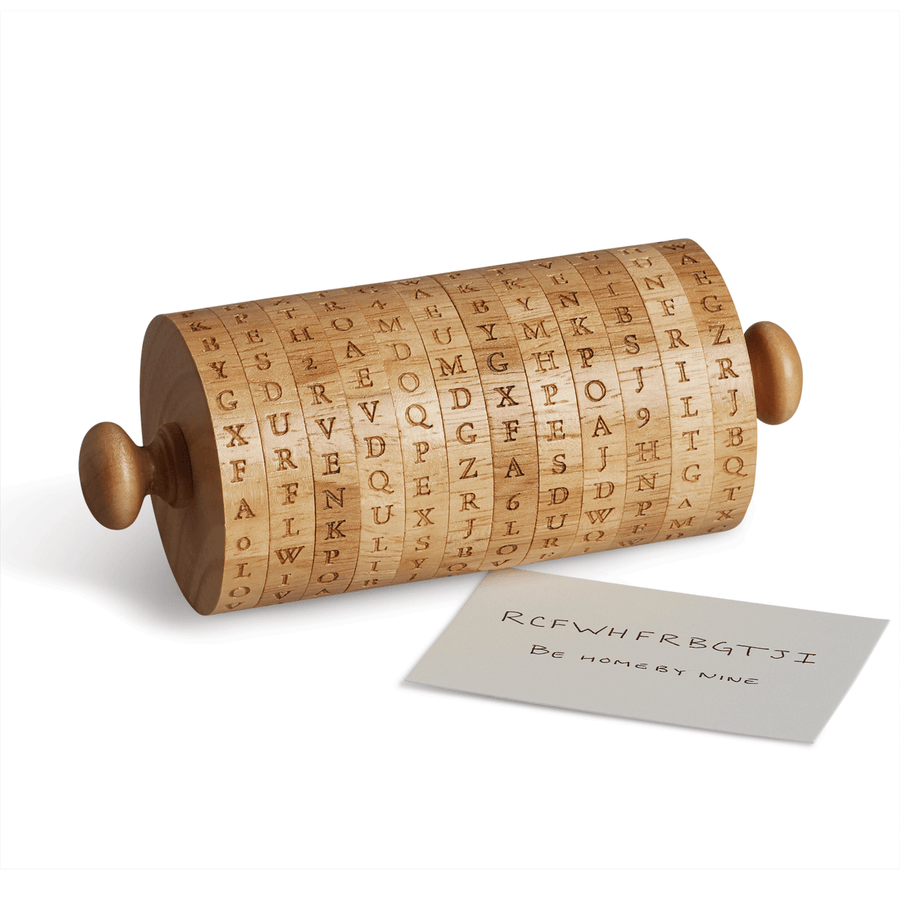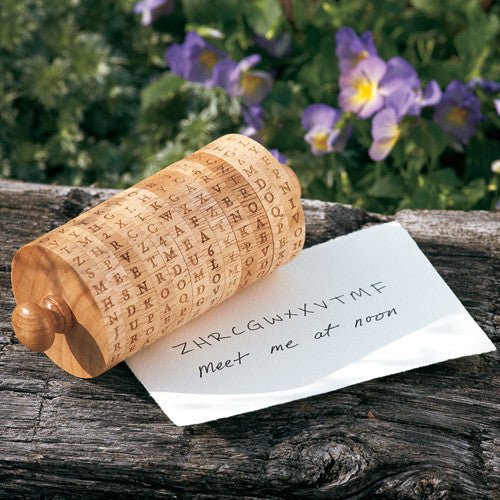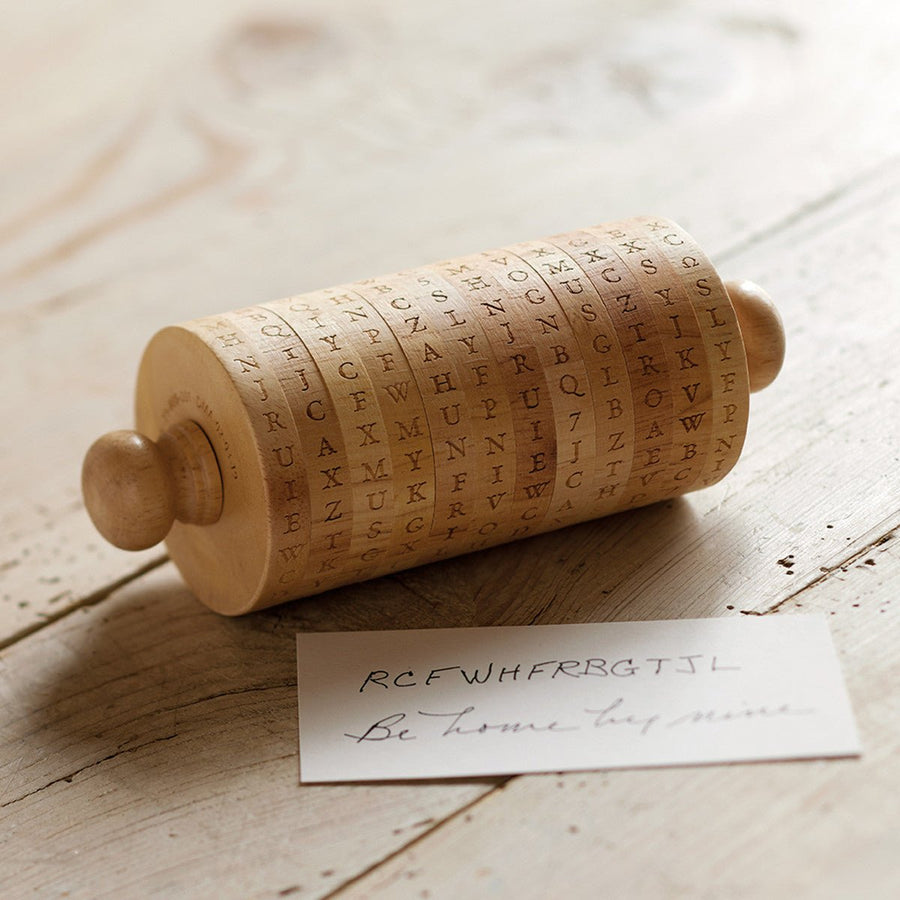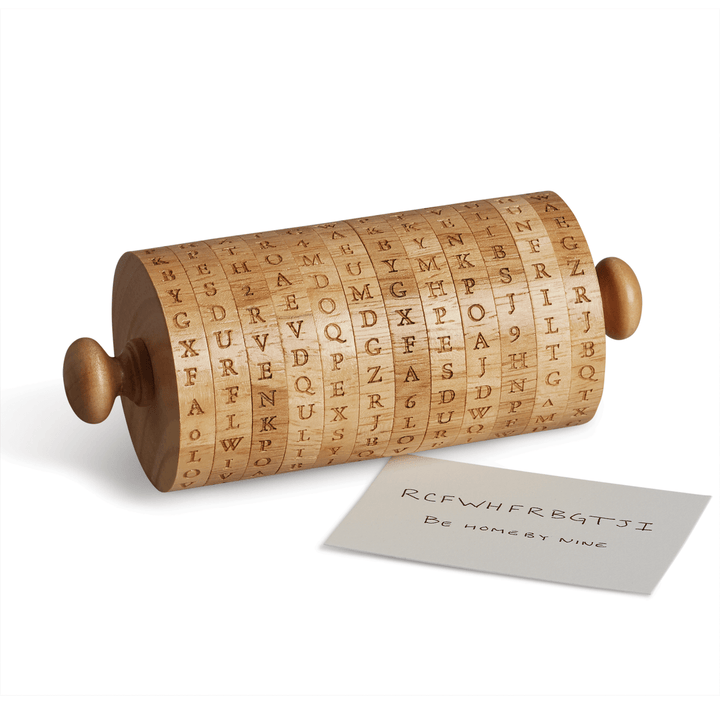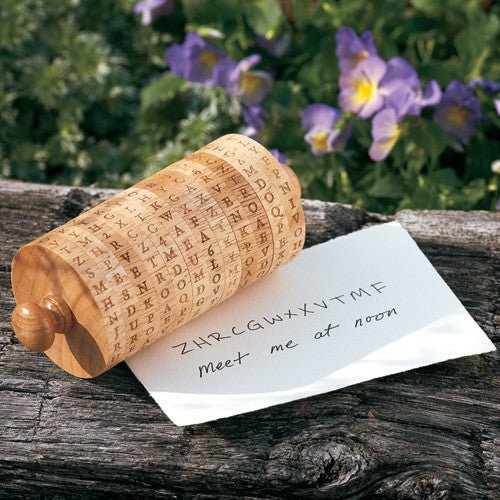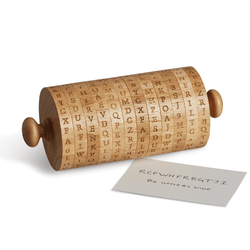While serving as President George Washington's secretary of state (1790-1793), Thomas Jefferson devised an ingenious and secure method to encode and decode messages: the wheel cipher. During the American Revolution, Jefferson had relied primarily on messengers to hand-carry sensitive letters, but codes became an essential part of his correspondence when he was America's minister to France (1784-1789) since European postmasters opened and read all letters passing through their command.
Jefferson's wheel cipher consisted of twenty-six cylindrical wooden pieces, each threaded onto an iron spindle. The letters of the alphabet were inscribed on the edge of each wheel in a random order. By turning these wheels, words could be scrambled and unscrambled.
How to use a decoder wheel:
To code a message such as "meet me at noon", the letter 'm' is located on the wheel at the left end of the instrument; the next wheel is turned until the letter 'e' is adjacent to the 'm'; the third wheel is turned until the second 'e' is next to the first 'e'; and so on, until all words in the message are spelled out in up to 12 letters with no spaces between them. Each of the remaining rows of letters on the cylinder represents a different encryption of the message. To send the message, the sender copies the sequence of letters in any one row. The recipient arranges the letters on any row of his cylinder into the sequence received, and then rotates the whole cylinder until he recognizes a meaningful series of words.
6 1/4"l x 2 1/2" dia. Recommended for ages 5 and up.
Can you crack the code? Visit this activities-at-home page on Monticello’s website for ciphers you can solve at home.
Your Purchase Supports Thomas Jefferson's Monticello
-
Decor
Decor

Inspired by the elegant, classic style of Jefferson’s Monticello.Decor & More
Shop Now
"No occupation is so delightful to me as the culture of the earth, and no culture comparable to that of the garden."Thomas Jefferson
Shop Now
Monticello's own gifts, decor, furniture and moreOnly at Monticello
Shop Now
Entertain with elegance and style inspired by Monticello.For outdoors or in the kitchen
Shop Now
100's of unique gifts inspired by Thomas Jefferson and American HistoryFind something for everyone
Shop Now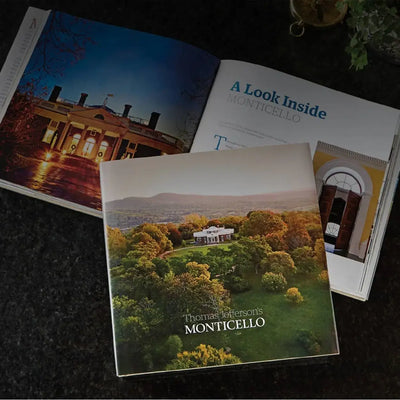
Browse our full library about Jefferson, Monticello and American History"I cannot live without books"
Shop Now
Monticello Inspired Jewelry, Apparel & AccessoriesDress with style.
Shop Now -
Entertaining
Entertaining

Inspired by the elegant, classic style of Jefferson’s Monticello.Decor & More
Shop Now
"No occupation is so delightful to me as the culture of the earth, and no culture comparable to that of the garden."Thomas Jefferson
Shop Now
Monticello's own gifts, decor, furniture and moreOnly at Monticello
Shop Now
Entertain with elegance and style inspired by Monticello.For outdoors or in the kitchen
Shop Now
100's of unique gifts inspired by Thomas Jefferson and American HistoryFind something for everyone
Shop Now
Browse our full library about Jefferson, Monticello and American History"I cannot live without books"
Shop Now
Monticello Inspired Jewelry, Apparel & AccessoriesDress with style.
Shop Now -
Garden

Inspired by the elegant, classic style of Jefferson’s Monticello.Decor & More
Shop Now
"No occupation is so delightful to me as the culture of the earth, and no culture comparable to that of the garden."Thomas Jefferson
Shop Now
Monticello's own gifts, decor, furniture and moreOnly at Monticello
Shop Now
Entertain with elegance and style inspired by Monticello.For outdoors or in the kitchen
Shop Now
100's of unique gifts inspired by Thomas Jefferson and American HistoryFind something for everyone
Shop Now
Browse our full library about Jefferson, Monticello and American History"I cannot live without books"
Shop Now
Monticello Inspired Jewelry, Apparel & AccessoriesDress with style.
Shop Now -
Fashion

Inspired by the elegant, classic style of Jefferson’s Monticello.Decor & More
Shop Now
"No occupation is so delightful to me as the culture of the earth, and no culture comparable to that of the garden."Thomas Jefferson
Shop Now
Monticello's own gifts, decor, furniture and moreOnly at Monticello
Shop Now
Entertain with elegance and style inspired by Monticello.For outdoors or in the kitchen
Shop Now
100's of unique gifts inspired by Thomas Jefferson and American HistoryFind something for everyone
Shop Now
Browse our full library about Jefferson, Monticello and American History"I cannot live without books"
Shop Now
Monticello Inspired Jewelry, Apparel & AccessoriesDress with style.
Shop Now -
Gifts
Gifts

Inspired by the elegant, classic style of Jefferson’s Monticello.Decor & More
Shop Now
"No occupation is so delightful to me as the culture of the earth, and no culture comparable to that of the garden."Thomas Jefferson
Shop Now
Monticello's own gifts, decor, furniture and moreOnly at Monticello
Shop Now
Entertain with elegance and style inspired by Monticello.For outdoors or in the kitchen
Shop Now
100's of unique gifts inspired by Thomas Jefferson and American HistoryFind something for everyone
Shop Now
Browse our full library about Jefferson, Monticello and American History"I cannot live without books"
Shop Now
Monticello Inspired Jewelry, Apparel & AccessoriesDress with style.
Shop Now -
Exclusives
Exclusives

Inspired by the elegant, classic style of Jefferson’s Monticello.Decor & More
Shop Now
"No occupation is so delightful to me as the culture of the earth, and no culture comparable to that of the garden."Thomas Jefferson
Shop Now
Monticello's own gifts, decor, furniture and moreOnly at Monticello
Shop Now
Entertain with elegance and style inspired by Monticello.For outdoors or in the kitchen
Shop Now
100's of unique gifts inspired by Thomas Jefferson and American HistoryFind something for everyone
Shop Now
Browse our full library about Jefferson, Monticello and American History"I cannot live without books"
Shop Now
Monticello Inspired Jewelry, Apparel & AccessoriesDress with style.
Shop Now -
Books
Books

Inspired by the elegant, classic style of Jefferson’s Monticello.Decor & More
Shop Now
"No occupation is so delightful to me as the culture of the earth, and no culture comparable to that of the garden."Thomas Jefferson
Shop Now
Monticello's own gifts, decor, furniture and moreOnly at Monticello
Shop Now
Entertain with elegance and style inspired by Monticello.For outdoors or in the kitchen
Shop Now
100's of unique gifts inspired by Thomas Jefferson and American HistoryFind something for everyone
Shop Now
Browse our full library about Jefferson, Monticello and American History"I cannot live without books"
Shop Now
Monticello Inspired Jewelry, Apparel & AccessoriesDress with style.
Shop Now - Sale







